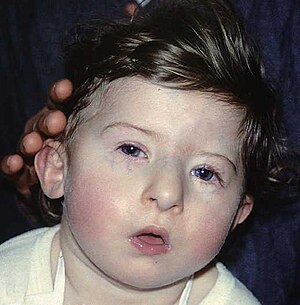22q11.2 deletion syndrome
| DiGeorge syndrome | |
|---|---|
| Synonyms | DiGeorge anomaly, velocardiofacial syndrome (VCFS), Shprintzen syndrome, conotruncal anomaly face syndrome (CTAF), Takao syndrome, Sedlackova syndrome, Cayler cardiofacial syndrome, Strong syndrome, congenital thymic aplasia, thymic hypoplasia, 22q11.2 deletion syndrome |
 |
|
| A child with DiGeorge syndrome | |
| Classification and external resources | |
| Specialty | Medical genetics |
| ICD-10 | D82.1 |
| ICD-9-CM | 279.11, 758.32 |
| OMIM | 188400 |
| DiseasesDB | 3631 |
| eMedicine | med/567 ped/589derm/716 |
| Patient UK | DiGeorge syndrome |
| MeSH | D004062 |
| GeneReviews | |
| Orphanet | 567 |
DiGeorge syndrome, also known as 22q11.2 deletion syndrome, is a syndrome caused by the deletion of a small segment of chromosome 22. It is a common genetic disorder resulting in medical complications, cognitive impairment, and brain morphologic changes.
DiGeorge syndrome is the most common microdeletion syndrome characterized by low copy repeats and the deletion occurs near the middle of the chromosome at a location designated 22q11.2—signifying its location on the long arm of one of the pair of chromosomes 22, on region 1, band 1, sub-band 2. The inheritance pattern is autosomal dominant and it has a prevalence estimated at 1:4000. The syndrome was described in 1968 by the pediatric endocrinologist Angelo DiGeorge. 22q11 deletion is also associated with truncus arteriosus and tetralogy of Fallot. The complex medical care may benefit from a multidisciplinary approach to improve the function of many organ systems.
The features of this syndrome vary widely, even among members of the same family, and affect many parts of the body. Characteristic signs and symptoms may include birth defects such as congenital heart disease, defects in the palate, most commonly related to neuromuscular problems with closure (velopharyngeal insufficiency), learning disabilities, mild differences in facial features, and recurrent infections. Infections are common in children due to problems with the immune system's T-cell-mediated response that in some patients is due to an absent or hypoplastic thymus. DiGeorge syndrome may be first spotted when an affected newborn has heart defects or convulsions from hypocalcemia due to malfunctioning parathyroid glands and low levels of parathyroid hormone (parathormone). Affected individuals may also have other kinds of birth defect including kidney abnormalities and significant feeding difficulties as babies. Gastrointestinal issues are also very common in this patient population. Digestive motility issues may result in constipation. Disorders such as hypothyroidism and hypoparathyroidism or thrombocytopenia (low platelet levels), and psychiatric illnesses are common late-occurring features.
...
Wikipedia
